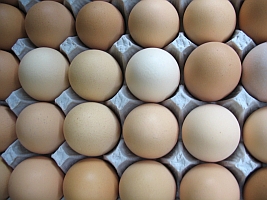 Food scientists at Purdue University in Indiana have shown that rapid cooling of just-laid eggs adds weeks to their shelf life. The process for achieving these results is described in the June issue of the journal Poultry Science (paid subscription required).
Food scientists at Purdue University in Indiana have shown that rapid cooling of just-laid eggs adds weeks to their shelf life. The process for achieving these results is described in the June issue of the journal Poultry Science (paid subscription required).
Kevin Keener, a food science professor at Purdue, led the research, which uses liquid carbon dioxide to stabilize the proteins in egg whites. This process enables newly laid eggs to maintain the highest-freshness rating of AA for 12 weeks, compared to six weeks using current methods. Statistical tests using industry standard Haugh units of egg freshness, show no difference between freshly laid eggs and those using the rapid-cooling method after 12 weeks.
In this process, eggs are placed in a cooling chamber and carbon dioxide gas at about minus 110 degrees Fahrenheit is generated. The cold gas is circulated around the eggs and forms a thin layer of fine ice inside the eggshell, which cools the eggs within minutes. After treatment, the ice layer melts and quickly lowers an egg’s internal temperature to below 45 degrees, the temperature at which salmonella can no longer grow.
This thin layer of ice, says Keener, strengthens the proteins in the membrane surrounding the egg yolk. The membrane acts as a barrier to keep bacteria from reaching the yolk, a nutrient-rich reservoir that bacteria could use as a food source. “The structural integrity of the yolk membrane stays strong longer, which may provide a food safety benefit,” says Keener. “The membrane being stronger would be another defense against bacterial invasion, such as salmonella.”
Current egg processing methods pack 30 dozen eggs in a case, in rooms at more than 100 degrees. The eggs are then placed on pallets, with 30 cases to a pallet and placed in refrigerated coolers. Keener says that eggs in the middle of the pallet can take up to six days to cool to the target temperature of 45 degrees.
Keener, a technical consultant to the American Egg Board and a member of the United Egg Producers Scientific Advisory Panel, says the extended shelf life could open up export markets for eggs. “You could send eggs anywhere in the world if you could get even eight weeks of shelf life at AA quality,” Keener notes. “We’re seeing 12 weeks.”
In the following video, Keener tells more about this research.
- Genomic Sequencing Precisely Targets Food Pathogens
- Study: Food Scares and Product Recalls Increasing
Photo: Melissa Sanders/Flickr
* * *

 RSS - Posts
RSS - Posts
You must be logged in to post a comment.